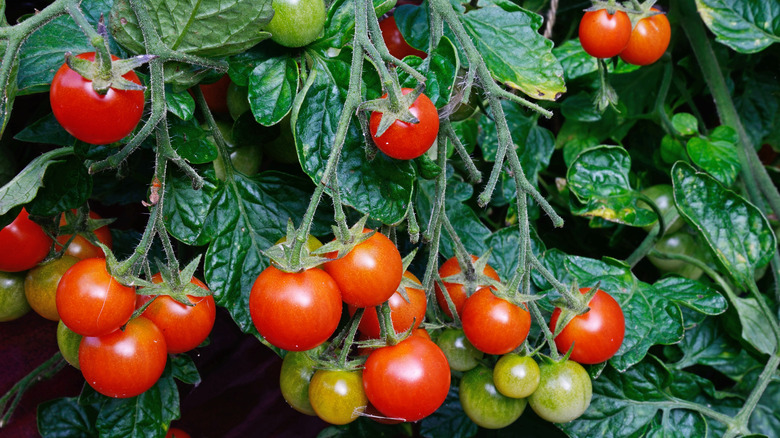Why Some Grocery Store 'Vine-Ripened' Tomatoes Are Lying To You
Food marketing can be a blessing or a curse. On the one hand, the wealth of information greatly improves our knowledge of the foods we consume, and it often highlights new products or provides seasonal tips and kitchen tricks. But sometimes the things left unsaid or under-explained can be misleading, especially when it comes to enticing product labels. Hello, vine-ripened tomatoes.
The visual of plump red tomatoes (Solanum lycopersicum) perching in piled-high bins, with stems and vines still attached, is enough to make you scoop them up by the dozens. Add the moniker of "vine-ripened," and you just know they'll transform any dish you lovingly create. But are those summery little grocery-store lovelies lying to you?
Maybe, if the name is what supposedly differentiates vine-ripened from post-vine-ripened Roma, Compari, San Marzano, beefsteak, heirloom, and any of the reported 10,000 types of tomatoes found around the world. Taste varies by species, but it can also be determined by how long the tomatoes hang on their vines before heading to supermarkets near and far. The longer they remain attached to the plant during the growing process, the more flavorful and aromatic they become. In addition, the tomatoes continue to absorb powerful nutrients, and they tend to ripen more evenly than those picked early and left to ripen during long journeys from field to store — but the subtle line between truth and consequence lies in how the industry defines "vine-ripened."
Stages of tomato growth and classification
The logic behind purchasing vine-ripened tomatoes comes down to flavor and nutritional value, both of which abound in most any type of tomato. However, careful phrasing sometimes blurs the lines of transparency. Though some tomatoes with stems and leaves still attached get marketed as "vine-ripened," the USDA uses the more neutral term of "tomatoes on the vine." Farmers claim the "vine-ripened" descriptor when the vines get cut at a certain growth stage, which isn't actually when the fruits are ripe. In fact, they're mostly still green and continue to mature over time.
Within the six stages of tomato growth, the second "breaker stage" represents when they can be called "vine-ripened." That's because, at this crucial stage, the tomato has absorbed all the compounds and sugars it needs to ripen and reach maturation on its own. Specifically, the tinges of red and pink color indicate the internal production of ethylene gas that facilitates ripening. There may still be advantages to leaving the stems and leaves attached, but they don't necessarily mean you're buying a cluster of tomatoes that fully ripened in the open air and warm sunshine. To guarantee a ripe tomato plucked ready-to-eat from the vine, you may need to grow it in your own garden.

